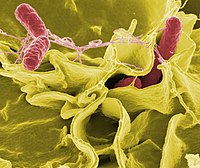
Photo from wikipedia
Non-typhoidal Salmonella strains are responsible for invasive infections associated with high mortality and recurrence in sub-Saharan Africa, and there is strong evidence for clonal relapse following antibiotic treatment. Persisters are… Click to show full abstract
Non-typhoidal Salmonella strains are responsible for invasive infections associated with high mortality and recurrence in sub-Saharan Africa, and there is strong evidence for clonal relapse following antibiotic treatment. Persisters are non-growing bacteria that are thought to be responsible for the recalcitrance of many infections to antibiotics. Toxin–antitoxin systems are stress-responsive elements that are important for Salmonella persister formation, specifically during infection. Here, we report the analysis of persister formation of clinical invasive strains of Salmonella Typhimurium and Enteritidis in human primary macrophages. We show that all the invasive clinical isolates of both serovars that we tested produce high levels of persisters following internalization by human macrophages. Our genome comparison reveals that S. Enteritidis and S. Typhimurium strains contain three acetyltransferase toxins that we characterize structurally and functionally. We show that all induce the persister state by inhibiting translation through acetylation of aminoacyl-tRNAs. However, they differ in their potency and target partially different subsets of aminoacyl-tRNAs, potentially accounting for their non-redundant effect.The recalcitrance of many infections to antibiotic treatment may be due to the presence of ‘persisters’, or non-growing, antibiotic-tolerant bacteria. Here, the authors study the structures and functions of aminoacyl-tRNA acetyltransferase toxins, and their roles in persister formation in Salmonella.
Journal Title: Nature Communications
Year Published: 2018
Link to full text (if available)
Share on Social Media: Sign Up to like & get
recommendations!